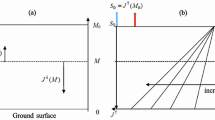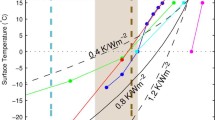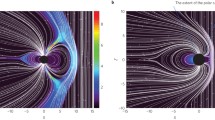Abstract
CURRENT models for the evolution of the Sun require an increase in solar luminosity by 25% since the formation of the Solar System1. Such an increase in the solar constant should have profound effects on the terrestrial climate, but there is no evidence from the fossil record of a corresponding change in the Earth's global mean temperature2. This apparent conflict cannot be explained by the apparent inability of solar models to account for the low observed neutrino flux3. Even models that are forced to fit the neutrino data require a similar increase in the solar luminosity. As Newman and Rood1 state: “a faint young Sun is one of the most unavoidable consequences of stellar structure considerations”. We discuss here whether CO2–H2O in a weakly reducing atmosphere could have caused this change in the early Earth's temperature by the so-called greenhouse effect.
Similar content being viewed by others
References
Newman, M. J. & Rood, R. T. Science 198, 1035 (1977).
Knauth, L. P. & Epstein, S. Geochim. cosmochim. Acta 40, 1095 (1976).
Davis, R. & Evans, J. M. Bull. Am. phys. Soc. 21, 683 (1976).
Sagan, C. & Mullen, G. Science 177, 52 (1972).
Hart, M. H. Icarus 33, 23 (1978).
Walker, J. C. G. in The Early History of the Earth (ed. Windley, B. F.) 535 (Wiley, New York 1976).
Anders, E. & Owen, T. Science 198, 453 (1977).
Pagel, B. E. J. Proc. 2nd Symp. on the Origin and Distribution of the Elements (Int. Ass. Geochem. and Cosmochem., Paris/UNESCO, in the press).
Kuhn, W. R. & S. K., Atreya, Icarus (in the press).
Eugster, H. P. in The Encyclopaedia of Geochemistry and Environmental Sciences; (ed. Fairbridge, R. W.) 29 (Van Nostrand, New York, 1972).
Neukum, G. & Wise, D. U. Science 194, 1381 (1976).
Miller, S. L. & Orgel, L. E. The Origins of Life on the Earth (Prentice-Hall, Englewood Cliffs, 1974).
Abelson, P. H. Proc. natn. Acad. Sci. U.S.A. 55, 1365 (1966).
Augustsson, T. & Ramanathan, V., J. atmos. Sci. 34, 448 (1977).
S. H. Schneider, J. atmos. Sci. 32, 2060 (1975).
J. O. Roads, J. atmos. Sci. 35, 753 (1978).
R. D. Cess, J. atmos. Sci. 33, 1831 (1976).
M. I. Budyko, Climate and Life (Academic, New York, 1974).
Lian, M. S. & Cess, R. D. J. atmos. Sci. 34, 1058 (1977).
Wetherald, R. T. & Manabe, S. J. atmos. Sci. 32, 2044 (1975).
Hutchinson, G. E. in The Earth as a Planet (ed. Kuiper, G. P.) (University of Chicago Press, 1954).
J. E., Lovelock & Margulis, L. Tellus 26, 2 (1974).
Author information
Authors and Affiliations
Rights and permissions
About this article
Cite this article
OWEN, T., CESS, R. & RAMANATHAN, V. Enhanced CO2 greenhouse to compensate for reduced solar luminosity on early Earth. Nature 277, 640–642 (1979). https://doi.org/10.1038/277640a0
Received:
Accepted:
Published:
Issue Date:
DOI: https://doi.org/10.1038/277640a0
- Springer Nature Limited
This article is cited by
-
Palaeozoic cooling modulated by ophiolite weathering through organic carbon preservation
Nature Geoscience (2024)
-
Earth’s long-term climate stabilized by clouds
Nature Geoscience (2021)
-
Is the Faint Young Sun Problem for Earth Solved?
Space Science Reviews (2020)
-
Effects of primitive photosynthesis on Earth’s early climate system
Nature Geoscience (2018)
-
Historical path of traditional and modern idea of ‘conscious universe’
Quality & Quantity (2017)





